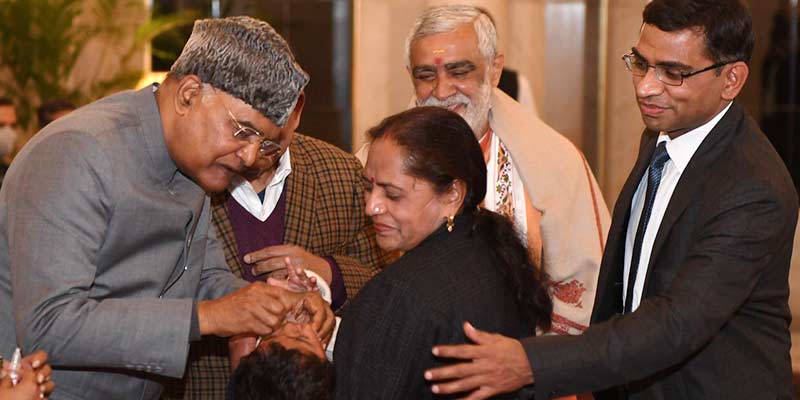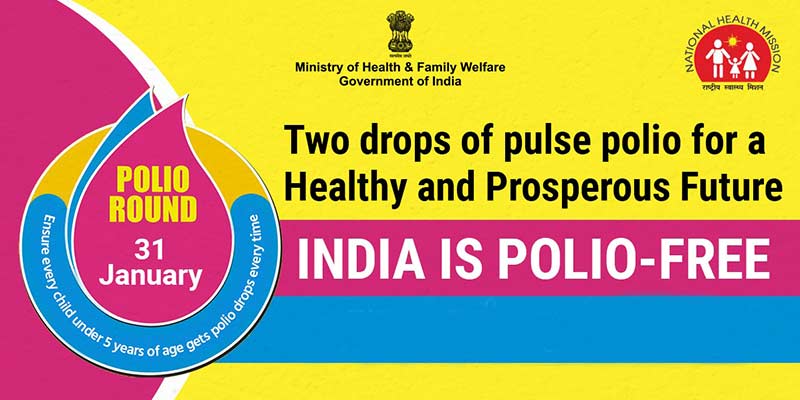- India
- Jan 31
Explainer / Pulse Polio Immunization programme
• President Ram Nath Kovind 30 launched the pulse polio programme for 2021 by administering polio drops to children under the age of five at the Rashtrapati Bhawan.
• President Kovind and First Lady Savita Kovind administered polio drops to children on the eve of the National Immunization Day, which is observed on January 31 and is also popularly known as ‘Polio Ravivar’.
Pulse Polio Immunization programme
• With the global initiative of eradication of polio following World Health Assembly resolution in 1988, Pulse Polio Immunization programme was launched in India in 1995.
• National Immunization Days (NIDs) are held across India twice a year, with the government of India setting out to give two drops of oral polio vaccine (OPV) to every child in the country under the age of five.
• The scale is extraordinary, with more than 17.2 crore children immunised by 2.4 million vaccinators who visit every house in every city, town and village across the country. The drive is supported by about 1.5 lakh supervisors and many civil society organisations, WHO, UNICEF, etc.
• Several Sub-National Immunisation Days (SNIDs) are also held annually in the highest-risk states.
• On February 24, 2012 WHO removed India from the list of countries with active endemic wild polio virus transmission after reporting the last case of polio virus in the country in January 2011.
• Subsequently, on March 27, 2014, India along with 10 other countries of South East Asia Region was declared polio-free by the Regional Certification Commission (RCC) of WHO.
• India has maintained polio-free status as no wild polio virus case has been reported since January 2011.
To maintain the polio-free status, country is implementing the following strategies:
• Maintaining community immunity through high quality of national and sub-national polio rounds each year, apart from routine immunization.
• Polio vaccination is provided to all eligible children round the clock through special booths set up at international borders (both Rail and Road routes) — Pakistan, Bangladesh, Bhutan, Nepal and Myanmar. As on October 15, 2019, 1.40 crore children were vaccinated in these border posts.
• Travel advisory has been issued for polio vaccination for those travelling between India and eight other countries — Pakistan, Afghanistan, Nigeria, Kenya, Ethiopia, Somalia, Syria and Cameroon. Till September 2019, more than 2.98 lakh travellers have been vaccinated with OPV (oral polio vaccine).
• An Emergency Preparedness and Response Plan (EPRP) have been put in place under which Rapid Response Teams (RRT) are set up in every states/UTs for timely action in case of any occurrence of a polio case in the country.
• As a part of Polio Endgame Strategy, India has introduced Inactivated Polio Vaccine (IPV) across the country to provide double protection against polio.
• Acute Flaccid Surveillance (AFP) and Environmental Surveillance across the country (which act as surrogate indicator for polio virus transmission) are being strengthened at Mumbai, Delhi, Patna, Kolkata, Punjab, Hyderabad, Lucknow, West Bengal and Gujarat.
Efforts for strengthening immunization
• Health minister Harsh Vardhan highlighted the mitigation measures and the efforts in strengthening routine immunization by the government. The lessons learnt from polio programme are being implemented to strengthen routine immunization by carrying out Mission Indradhanush, Gram Swaraj Abhiyan, Extended Gram Swaraj Abhiyan and Intensified Mission Indradhanush I and II.
• In order to close gaps that might have emerged during the COVID-19 pandemic, another phase of Intensified Mission Indradhanush (IMI 3.0) has been planned in 250 high risk districts of the country during February and March 2021.
• Also, guidance for conduction of Sub-National Immunization Days for polio and sensitive surveillance of vaccine preventable diseases during pandemic has also been issued to states.
Mission Indradhanush
• Mission Indradhanush was launched in December 2014. The focus of the special drive was to improve immunization coverage in select districts and cities to ensure full immunization to more than 90 per cent.
• Under this drive, focus is given on pockets of low immunization coverage and hard to reach areas where the proportion of unvaccinated and partially vaccinated children is highest.
• A total of six phases of Mission Indradhanush have been completed covering 554 districts across the country.
• It was also identified as one of the flagship schemes under Gram Swaraj Abhiyan (16,850 villages across 541 districts) and Extended Gram Swaraj Abhiyan (48,929 villages across 117 aspirational districts).
• While the first two phases of Mission Indradhanush resulted in 6.7% increase in full immunization coverage in a year, a recent survey carried out in 190 districts covered in Intensified Mission Indradhanush (5th phase of Mission Indradhanush) shows 18.5% points increase in full immunization coverage as compared to NFHS-4 survey carried out in 2015-16.
Manorama Yearbook app is now available on Google Play Store and iOS App Store


